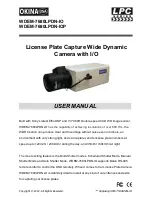
CHEETAH Hardware User’s Manual
Imperx, Inc.
Rev. 6.2
6421 Congress Ave.
7/7/2015
Boca Raton, FL 33487
+1 (561) 989-0006
35 of 152
sequentially. In this mode, every pixel in the array is exposed during the same time period as
determined by the cameras exposure control setting. This is useful if an object within the
scene is moving, since all pixels within the array capture the image at the same instant in
time. Global shutter mode introduces more noise into the image and therefore is not as
sensitive as rolling shutter operation. In rolling shutter mode, each line with imaging array is
reset and exposed at a slightly different time period. If there is motion within the scene, this
can result in distortions to the object in motion, but the size of these distortions will vary
based on the readout rate of the camera and the speed of the object in motion. Many
applications are not sensitive to these slight distortions. Rolling shutter mode has much
more sensitivity as compared to global shutter mode and is useful in light starved
applications.
2.3 A/D DIGITIZATION
The user has the ability to select the internal digitization level within the image sensor to
trade-off dynamic range for frame rate. When the ADC Selector is set to 12-bit digitization
level, the maximum frame rate is reduced to about 26 frames per second limited by the ADC
settling time. When the ADC selector is set to 10-bits, the A/D converter settling time is
reduced and the maximum camera output frame rate increases. The ADC selector setting
sets the internal camera digitization level, the output panel allows the user to select between
10 and 12-bit digitization.
2.4
FRAME TIME CONTROL
2.4.1 Internal Line and Frame Time Control
The camera speed (frame rate) depends on the CMOS “read-out” time – the time
necessary to read all the pixels out of the CMOS imager. The frame rate can be
calculated using the following Formula 1.1:
Frame rate [fps] = 1 / read-out time [sec]
(1.1)
The user can program the camera to run slower than the nominal speed preserving
the camera full resolution by extending the camera line time (the time required to
read one line out of the CMOS imager) and camera frame time (the time required to
read the entire frame out of the CMOS imager). Since the image sensor readout
speed exceeds the Camera Link interface output rate, the camera automatically sets a
minimum line time based on the number of output taps and bit depth selected and
this sets the maximum frame rate consistent with the available bandwidth of the
















































